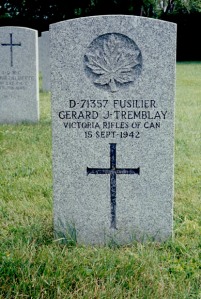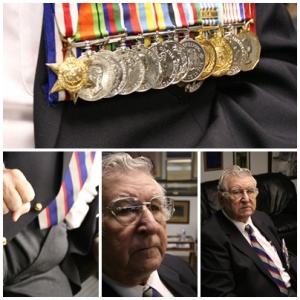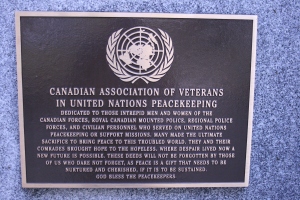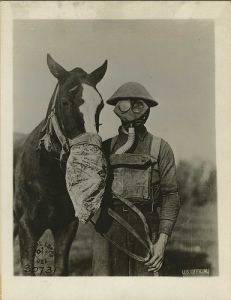London 1940
A news reel illustrating how French Canadians soldiers replaced the Welsh Guards at Buckingham Palace
Vodpod videos no longer available.
Posted in Uncategorized on +00002009-01-25T19:47:00+00:00312009b+00:00Sun, 25 Jan 2009 19:47:00 +0000 31, 2008| Leave a Comment »
London 1940
A news reel illustrating how French Canadians soldiers replaced the Welsh Guards at Buckingham Palace
Vodpod videos no longer available.
Posted in Vernon Masterman, War Graves Photographic Project on +00002009-01-23T01:00:29+00:00312009b+00:00Fri, 23 Jan 2009 01:00:29 +0000 31, 2008| Leave a Comment »
 source: http://www.collectionscanada.gc.ca/obj/022/f1/e002343046.jpg
source: http://www.collectionscanada.gc.ca/obj/022/f1/e002343046.jpg
An amazing project is called the War Graves Photographic Project which aims to photograph every war grave , individual memorial, MoD grave and family memorial of serving military personnel from WW 1 to the present day.
The goal is 1.75 million graves and memorials from commonwealth veterans.
To volunteer your time to help
Contact directly
steve@twgpp.org or derek@twgpp.org
Canadian coordinator is Vernon Masterman
Posted in Uncategorized on +00002009-01-18T22:00:03+00:00312009b+00:00Sun, 18 Jan 2009 22:00:03 +0000 31, 2008| Leave a Comment »

During the Suez Crisis of 1956, Secretary of State for External Affairs Lester B. Pearson – later Canada’s 14th Prime Minister brought into common use the term peacekeeping
Since 1947, Canadian Forces have been involved in 72 international operations leading up to the declaration of the Peacekeepers’ Day in Canada falls on 9 August
PA Daniel, Oshawa Resident served in Korea and Gaza as a peacekeeper during his 35 year career with the Canadian Military. He provides a short story while serving in Gaza
 Canadians as Peacemakers
Canadians as Peacemakers
New missions – The Cold War’s end signalled a new era of international co-operation at the United Nations. In the five years ending in 1996, the UN set up 24 new peacekeeping missions – six more than the total for the previous 43 years. UN peacekeeping hit an all-time high in late 2006, with more than 80,000 peacekeepers serving on 18 different missions.
New conflicts within states – Traditional peacekeeping took place between states, monitoring peace treaties to which all parties had agreed, and patrolling contested borders. Lately, more conflicts have been internal. Their sides are ‘non-state actors’, not governments. They are harder to define, making it harder to identify who should participate in peace negotiations. Also, there is often no clear area of conflict – fighting is spread through a country’s entire territory. In these cases, the international community is asked to create basic structures for peace and security, and take on responsibilities that used to be internal affairs of the state.
New actors: Conflict resolution is no longer the exclusive job of the UN. Regional organisations such as NATO, the Organisation for Security and Co-operation in Europe, and the Organisation for African Unity are also involved. In addition, a wide range of other civil and NGO organisations plays key roles in peace operations.
New skills – Because we now face more complex crises, we’ve begun to send people with a greater mix of skills. Military personnel now work with police and other experts to return conflict societies to security. These experts may include regional and municipal administrators; judges and prosecutors to develop judiciaries and run courts; media, health, tax and social policy advisors; child protection experts; facilitators and mediators; and even people to manage basic services such as sewage treatment plants or railways.
Canadian peacekeeping policy is evolving in new directions to meet changing conditions. This site explains how Canada has responded to these challenges to carry out today’s peace operations.
http://www.vac-acc.gc.ca/youth/sub.cfm?source=teach_resources/peacefact

http://www.dfait-maeci.gc.ca/department/history/Pearson-en.asp
http://www.unac.org/en/link_learn/fact_sheets/index.asp
http://www.forces.gc.ca//ite/operations/current_ops_e.asps
Posted in Uncategorized on +00002009-01-15T20:55:12+00:00312009b+00:00Thu, 15 Jan 2009 20:55:12 +0000 31, 2008| Leave a Comment »
Over two million allies soldiers were stationed in wartime Britain, over 500,000 Canadians were stationed in Britain between 1939 and 1945, combined with the 1 1/2 million American men, these men had a variety of affairs with local British women.
The BBC series Sex, Love and War details the stories of British women and their Canadian soldiers. This is not sexually explicit but a well done and sensitive documentary loyal to the gift of the storytellers. See the War Bride Story in the collection, meanwhile many ( numbers unknown) British women with children did not reunite with their Canadian lovers.
Link( Three part series)
http://video.google.com/videoplay?docid=6662574689212944978&hl=en
Posted in Uncategorized on +00002009-01-15T17:03:24+00:00312009b+00:00Thu, 15 Jan 2009 17:03:24 +0000 31, 2008| Leave a Comment »
Edwin Barnard Martin of the Essex Scottish Regiment(Captured at Dieppe in 1942) , CPL. John Gordon Galaher, Pvt. George Hale. At a military trial on Sept 28, 1945 they were sentenced to life imprisonment.
All were given a royal pardon in 1954
(Source documents of WW 2 Court Martial Records at ottawa Federal Records Centre in Tunney’s Pasture, microfilm Lot 44, Accession 72R6)
More information at
http://en.wikipedia.org/wiki/British_Free_corps
Documentary: The Brits Who Fought For Hitler
A nation reviles treachery, perhaps now more than ever. But the chronicles of recent history have ignored the most shameful episode of World War Two. The Britisches Freikorps unit of the Waffen SS served alongside the Nazis on the Eastern Front. Its members wore the death’s head insignia and took German rank. They helped defend Berlin even as Hitler retreated to his bunker. But each and every member was recruited from British, Canadian, Australian and South African soldiers who volunteered to betray their country. Recognising the potential propaganda value of the unit, the Nazis ordered 800 SS uniforms with Union Jack arm badges. Most Allied prisoners of war ignored or resisted recruitment tactics ranging from leaflet bombardment to bribery and torture. But some 200 Allied prisoners answered the Nazi call. Some were motivated by greed, or by sympathies with the fascist cause. Others were simply described by intelligence files of the time as of ‘weak character’, and found the opportunities offered by the Germans to drink and womanise too tempting. The British Free Corps was itself betrayed by one of its number who joined only to feed MI5 with information. John Brown, the quartermaster of a camp at Genshagen. As Germany collapsed, Brown’s information allowed the Allies to round up the traitors who often posed as fleeing PoWs. They were prosecuted and sentenced at court martial and treason trials. The intelligence files were quietly closed and access to the devastating information within was restricted. There was no cover-up, rather a conspiracy of indifference. For the first time on British Television, the British SS soldiers speak of their treachery, and their part in a failed German propaganda coup
Posted in Comedy, Uncategorized, World War Two on +00002009-01-15T16:19:17+00:00312009b+00:00Thu, 15 Jan 2009 16:19:17 +0000 31, 2008| Leave a Comment »
This BBC documentary posted at GoogleVideos looks at the clampdown on satire and other undesirable comedians as the Third Reich grew in power. The plight of specific groups (or “art”) tends to get lost in the scale of the much bigger human cost of WWII.
However here the film looks at how satire and jokes at Hitler’s expense were encouraged to some degree as he came into power but gradually anything deemed “subversive” was squeezed out and telling such jokes gradually became more and more dangerous. We hear about German comedians who are sentenced to hard labour in camps or even death as punishment for making jokes. This is recalled with well chosen recollections from a couple of people involved in the period and it serves to only make things worse by not being at all surprising. After this the film explores the general sense of humour on the street as the war started to turn back against German cities and civilians, where understandably there was a certain amount of gallows humour. Throughout the film the jokes are recreated by two German comedians
Posted in Uncategorized on +00002009-01-15T15:32:04+00:00312009b+00:00Thu, 15 Jan 2009 15:32:04 +0000 31, 2008| Leave a Comment »
A collection of short documentaries detailing the contributionof Canadians from WW One to the Afghanistan conflict.
The Power and the Grace
http://www.youtube.com/watch?v=wEpFmKx9yt8
http://www.youtube.com/watch?v=UEW1jpOVdFU
http://www.youtube.com/watch?v=arp6FEZqs
Canadian Nurses at the Front
Nursing sisters played a major role during the First World War. Between 1914 and 1918, 2,504 served in Europe.
http://www.youtube.com/watch?v=mPJ4JXp5wd8
World War One
http://www.youtube.com/watch?v=J3QJRM7tCI0
http://www.youtube.com/watch?v=EdJVfLA38tA
http://www.youtube.com/watch?v=bNdnx42ejug
http://www.youtube.com/watch?v=SNerOTB-OxQ
World War Two
http://www.youtube.com/watch?v=0Znr-eaov20
http://www.youtube.com/watch?v=ujlYmDWFI1I
http://www.youtube.com/watch?v=lvZCDfhoNxA
http://www.youtube.com/watch?v=QYo-FI8K4Vo
Canada at War
http://www.youtube.com/watch?v=KjquyqIH-4s
http://video.google.ca/videosearch?q=Canadian+military+documentaries&hl=en&emb=0#
http://video.google.ca/videosearch?q=Canadian+military+documentaries&hl=en&emb=0#
Tribute
http://www.youtube.com/watch?v=gNpJ4cNPBxE&feature=related
FactualTV has a collection of 88 Military streaming videos to watch on the European and Pacific WW 2 conflicts
Posted in Uncategorized on +00002009-01-14T14:24:45+00:00312009b+00:00Wed, 14 Jan 2009 14:24:45 +0000 31, 2008| Leave a Comment »
William Sam Magee provides a personal story after serving in World war Two
Posted in cartoon, World War Two on +00002009-01-12T23:15:05+00:00312009b+00:00Mon, 12 Jan 2009 23:15:05 +0000 31, 2008| Leave a Comment »
This is a collection of politically incorrect cartoons which were a staple at movie theatres during World World Two. Many of their story themes were adult oriented and aimed at the parents rather than children.
As the war years pressed on, actors and entertainers were actively engaged to help boast moral of the troops and the home guard , it is no wonder that the cartoons followed suit do a similar job. Interestingly these cartoons are far more racist and deliberate that the film noir movies and serials during the same period which worked overtime to influence public opinion.
We have set up another blog with a cross section of WW 2 cartoons from various video feeds including Disney, Tex Avery and a German Nazi cartoons
Posted in horses, Uncategorized, World War One on +00002009-01-12T20:27:58+00:00312009b+00:00Mon, 12 Jan 2009 20:27:58 +0000 31, 2008| 1 Comment »

(Flickr picture)
Germany’s use of poison gas during World War 1 meant that one had to have a gas mask for one’s horse too
Over 8 million horses died on all sides during World War One . Two and a half million horses were treated in veterinary hospitals with about two million being sufficiently cured that they could return to duty. Special acknowledge needs to be made to the Convalescent Horse Depots run by the Veterinary Corps
Note:
A great site dealing with the role and contribution of the light and draft horses go to http://www.firstworldwar.com/features/forgottenarmy.htm
In acknowledgement of the suffering of animals In 2004, at the 90th anniversary of the First World War, the UK erected a monument in Park Lane to honour all those animals who have suffered and died in warfare.
Gunner the Horse Story
Dawn Gilliant Hembling relays a personal story of her childhood growing up on the family farm in Granville Centre, Nova Scotia, during WW2 . She relays a story of a Clydesdale horse called Gunner which was destined to serve in France as a Field Gun Horse during WW One, fortunately for this horse, the war was over and it escaped the fate of other horses during World War One.